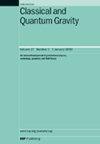Advanced charge control dynamics simulation for the LISA gravitational reference sensor
IF 3.6
3区 物理与天体物理
Q2 ASTRONOMY & ASTROPHYSICS
引用次数: 0
Abstract
A gravitational wave detector in space, the Laser Interferometer Space Antenna (LISA) will be able to detect gravitational waves in the frequency range of 0.1 mHz–1 Hz, adding to humanity’s knowledge of the dark cosmos. The LISA gravitational reference sensor contains a test mass (TM) and is used to determine the local inertial reference frame and as endpoints for the interferometry. The TM is surrounded by an electrode housing to detect changes in TM position and orientation, which is fed back to the spacecraft thrusters for drag-free control. As seen on LISA Pathfinder, the TM builds up charge over time from the space environment and needs to be discharged in order to keep the resulting force noise as low as possible. The operation of intelligently discharging the TM is known as charge control, and is one area of improvement to be explored for LISA. To explore new methods of TM discharge, UV LEDs will be pulsed synchronized with an existing 100 kHz high frequency electric field to facilitate photoelectron current direction and to achieve lower UV light powers by duty cycling. This paper addresses new pulsed methods for the LISA Charge Management System, which require in-depth modeling, analysis, and testing because space environment validation will not be possible prior to LISA launch. Therefore, it is necessary to model the dynamics of charge movement to determine the force noise contribution of pulsed continuous charge control. The charge dynamics model is described, and simulation results featured for charge control efficacy in a deep space radiation environment. Experimental testing of the simulation results could be done in the University of Florida Torsion Pendulum, a key technology to testing GRS performance in a space-like environment.LISA重力参考传感器的先进电荷控制动力学仿真
作为太空中的引力波探测器,激光干涉仪空间天线(LISA)将能够探测到0.1 mHz-1 Hz频率范围内的引力波,从而增加人类对黑暗宇宙的认识。LISA重力参考传感器包含一个测试质量(TM),用于确定局部惯性参考系和作为干涉测量的端点。TM被一个电极外壳包围,用于检测TM位置和方向的变化,并将其反馈给航天器推进器进行无拖曳控制。正如在LISA探路者上看到的那样,TM会随着时间的推移从空间环境中积累电荷,并且需要放电,以使产生的力噪声尽可能低。智能放电TM的操作被称为充电控制,是LISA需要探索的一个改进领域。为了探索新的TM放电方法,UV led将与现有的100 kHz高频电场脉冲同步,以促进光电子电流的方向,并通过占空比实现更低的紫外光功率。本文讨论了LISA电荷管理系统的新脉冲方法,这需要深入的建模、分析和测试,因为在LISA发射之前不可能进行空间环境验证。因此,有必要建立电荷运动动力学模型,以确定脉冲连续电荷控制的力噪声贡献。描述了深空辐射环境下电荷控制的动力学模型,仿真结果显示了深空辐射环境下电荷控制的有效性。仿真结果可以在佛罗里达大学的扭摆上进行实验测试,这是测试GRS在类空间环境下性能的关键技术。
本文章由计算机程序翻译,如有差异,请以英文原文为准。
求助全文
约1分钟内获得全文
求助全文
来源期刊

Classical and Quantum Gravity
物理-天文与天体物理
CiteScore
7.00
自引率
8.60%
发文量
301
审稿时长
2-4 weeks
期刊介绍:
Classical and Quantum Gravity is an established journal for physicists, mathematicians and cosmologists in the fields of gravitation and the theory of spacetime. The journal is now the acknowledged world leader in classical relativity and all areas of quantum gravity.
 求助内容:
求助内容: 应助结果提醒方式:
应助结果提醒方式:


